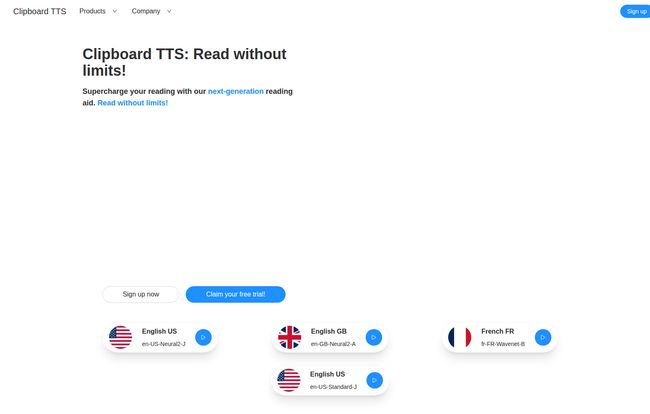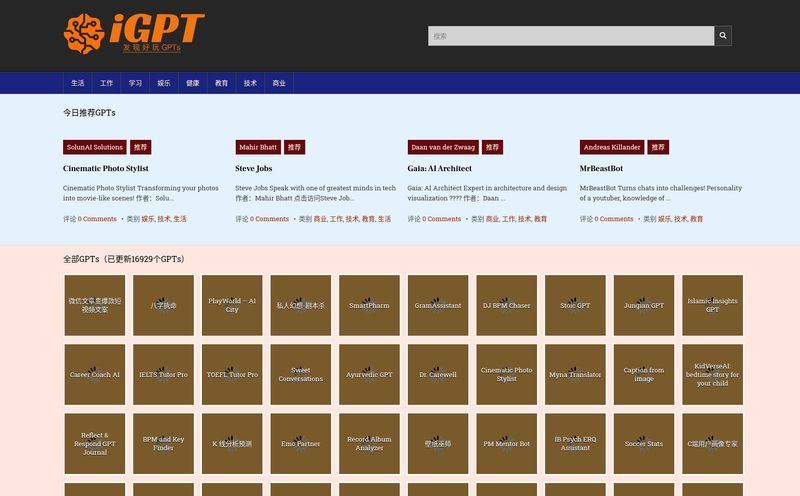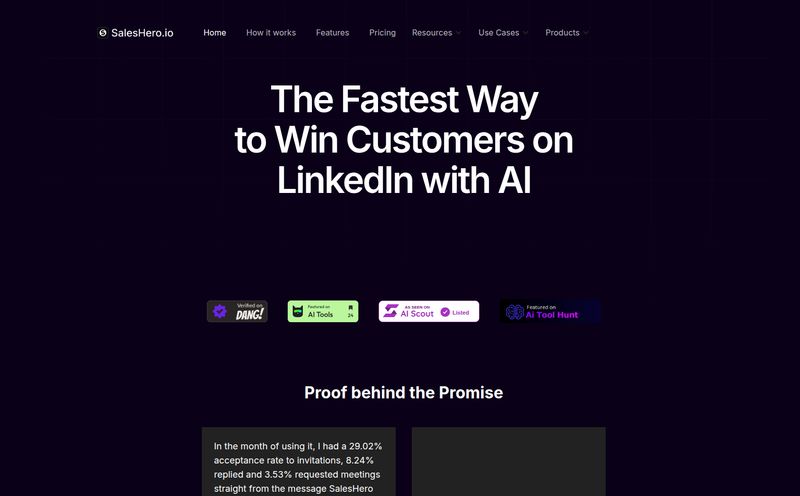I swear, some days my eyes just want to file for divorce from my brain. Between endless client briefs, doom-scrolling through social feeds, and trying to stay on top of industry news, the screen-time struggle is real. My eyeballs feel like two dried-up raisins by 3 PM. Sound familiar? I thought so. For years, I’ve relied on a cocktail of coffee and sheer willpower to get through mountains of text. Text-to-speech (TTS) tools have been around, sure, but most of them sounded like a robot that had gargled gravel. Pass.
Then I stumbled upon something called Clipboard TTS. The name is… functional, I’ll give it that. But the promise was intriguing: a “next-generation” reading aid. I’ve heard that before. But with claims of being dyslexia-friendly and having genuinely natural voices, my curiosity was piqued. So, I took it for a spin. And folks, I have some thoughts.
First Off, What Even is Clipboard TTS?
Let's get the basic idea out of the way. At its core, Clipboard TTS is exactly what it sounds like: a tool that reads text you've copied to your clipboard. It's deceptively simple. You highlight any text on your screen—an article, an email, a PDF, whatever—hit Ctrl+C (or Cmd+C for the Mac crowd), and this little app just starts talking to you. It turns the entire internet into an impromptu audiobook.
But calling it just a “TTS reader” feels like calling a Swiss Army knife just a “knife.” It’s the extra gadgets and the quality of the main blade that make all the difference. This tool is designed not just to read, but to make reading easier and more accessible for a whole range of people.
This Isn't Just for Skimming Articles
My initial thought was, “Great, I can get through my unread articles faster.” And yes, it’s fantastic for that. But as I played around with it, the bigger picture started to emerge. This is less about speed-reading and more about changing how we interact with written information.
A Genuine Lifeline for Dyslexia and Reading Hurdles
This is where Clipboard TTS really starts to shine. It's not just an afterthought; the dyslexia-friendly features are baked right into its DNA. I've worked with folks who have dyslexia, and the constant battle with walls of text is exhausting. This tool offers real, practical help. You can use colored Overlays to reduce visual stress, a common technique recommended by specialists. It also includes the OpenDyslexic font, which is specifically designed to increase readability for dyslexic users. Little tweaks, big impact.
One of the coolest features is something called BoldCue. It bolds the text as it’s being read, creating a visual pacer that helps your eyes follow along without getting lost. It's a simple idea, brilliantly executed. For anyone who finds their eyes jumping around the page, this is a game-changer.
The Productivity Angle for Professionals
Okay, back to my tribe: the busy professionals. Ever tried to proofread your own report after staring at it for five hours? Your brain starts auto-correcting your own mistakes. Having your own words read back to you in a clear, natural voice is like having a fresh pair of eyes—or ears, I guess. You catch awkward phrasing, typos and flow issues you’d otherwise miss. I’ve already used it to review this very blog post. It’s also brilliant for multitasking. I can “read” a long-form analysis while I’m organizing files or making coffee. It's found time.
The Features That Actually Make a Difference
Alright, let's pop the hood. A lot of apps throw a million features at you, but only a few are truly useful. Here’s what stood out to me with Clipboard TTS.
- The Voices Aren't Robots: This is the big one. The standard voices are good, way better than the default ones on your OS. But if you spring for the Ultimate plan, you get access to Google's WaveNet and Neural2 voices. Honestly, they are stunningly realistic. They have inflection. They pause. They sound... human. It makes listening for long periods not just tolerable, but genuinely enjoyable.
- A Pocket Translator: The app supports multiple languages and can even auto-translate text. Copy a paragraph in French, and it can read it back to you in English. For anyone working with international clients or trying to learn a new language, this is an incredible tool to have in your back pocket.
- It Reads Pictures (Yes, Really): The Image-to-Text feature (also known as OCR) is pure magic. You can drag a screenshot, a meme with a lot of text, or a photo of a document into the app, and it will extract the text and read it to you. I tested it on an uncopyable slide from a webinar presentation and it worked flawlessly. Mind. Blown.

Visit Clipboard TTS
Let's Talk Money: The Pricing Plans
Nothing’s ever free, right? Well, there is a free trial, which is great. But for ongoing use, there are two main tiers. I’ve broken them down in a simple table because who has time to decipher marketing-speak.
| Plan | Price | Key Features | Best For |
|---|---|---|---|
| Standard | £4.49 / month | 300k characters/month, standard voices, AI Assist, all dyslexia features, translation, OCR. | Casual users, students, or those testing the waters. A fantastic value. |
| Ultimate | £14.99 / month | 750k characters/month, all standard features, plus premium WaveNet & Neural2 voices, and more customization. | Power users, professionals, audiophiles, and anyone who will use it daily. The voices are worth it. |
My take? The Standard plan is more than enough for most people to see a huge benefit. But if you’re like me and can’t stand robotic voices, the upgrade to Ultimate for the premium voices alone is seriously tempting.
The Not-So-Shiny Bits
No tool is perfect, and it’s only fair to point out the wrinkles. My main gripe, if you can call it that, is the complete reliance on the clipboard. It's a core part of its identity, but sometimes I wish I could just click a button in my browser. It’s a workflow you have to get used to. It's not bad, just different.
Also, the “AI Assist” feature is labeled as experimental, and it feels that way. It’s a neat idea but not the main reason to get the app right now. Finally, there are character limits. 300,000 characters on the Standard plan sounds like a lot—and it is, it’s about the length of a long novel—but if you’re a truly heavy user, you might have to keep an eye on it.
My Final Verdict
So, is Clipboard TTS worth it? In my opinion, absolutely. It's one of those rare tools that delivers on its core promise and then surprises you with how much deeper it goes. It has successfully turned me from a TTS skeptic into a daily user. It’s not just about consuming content faster; its about consuming it better and with less strain.
For professionals, it's a productivity secret weapon. For students, it's a study aid. And for anyone with dyslexia or other reading challenges, I genuinely believe it could be a profoundly helpful tool that fosters a better relationship with the written word. It's a well-thought-out, high-quality piece of software that solves a real problem. And my raisins-for-eyeballs problem has definitely improved.
Frequently Asked Questions
1. How exactly does Clipboard TTS work?
It's pretty straightforward! You find any text you want to read on your computer, highlight it with your mouse, and copy it (using Ctrl+C or right-click and copy). The Clipboard TTS application, which runs in the background, automatically detects the new text on your clipboard and begins reading it aloud instantly.
2. Is Clipboard TTS actually effective for people with dyslexia?
Yes, it's one of its main strengths. It includes several features specifically designed for dyslexia support, such as colored screen overlays to reduce visual stress, the OpenDyslexic font for easier letter recognition, and the BoldCue feature that bolds text as it's being read to help with tracking.
3. Can it really read text from an image or a PDF?
It sure can. The app has a built-in Optical Character Recognition (OCR) function. You can drag an image file (like a JPG, PNG) or a screenshot directly into the app, and it will scan the image, extract any text it finds, and read it to you. This is perfect for infographics, presentations, or scanned documents.
4. What’s the main reason to choose the Ultimate plan over the Standard one?
The single biggest difference is the voice quality. The Ultimate plan gives you access to premium Google WaveNet and Neural2 voices, which are incredibly lifelike and natural-sounding. You also get a much higher monthly character count (750,000 vs 300,000) and more customization options. If you plan to listen for long periods, the voice upgrade is significant.
5. Is there a free trial to test it out?
Yes! The website mentions a free trial you can claim. It's the best way to see if the workflow and features fit your needs before committing to a paid plan. I'd definitely recommend starting there.



